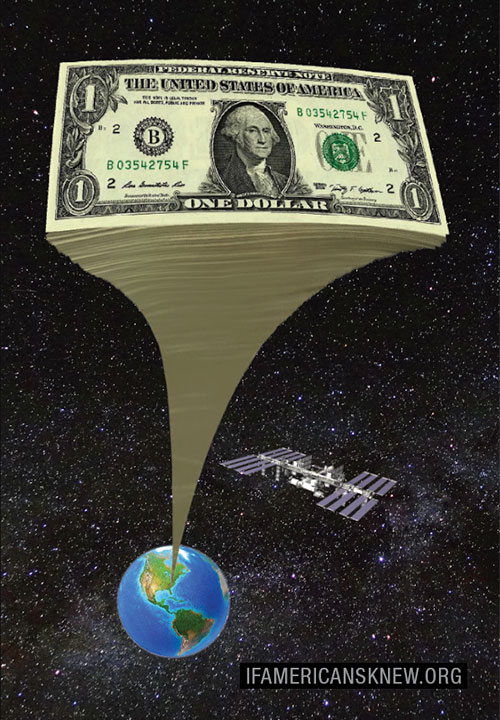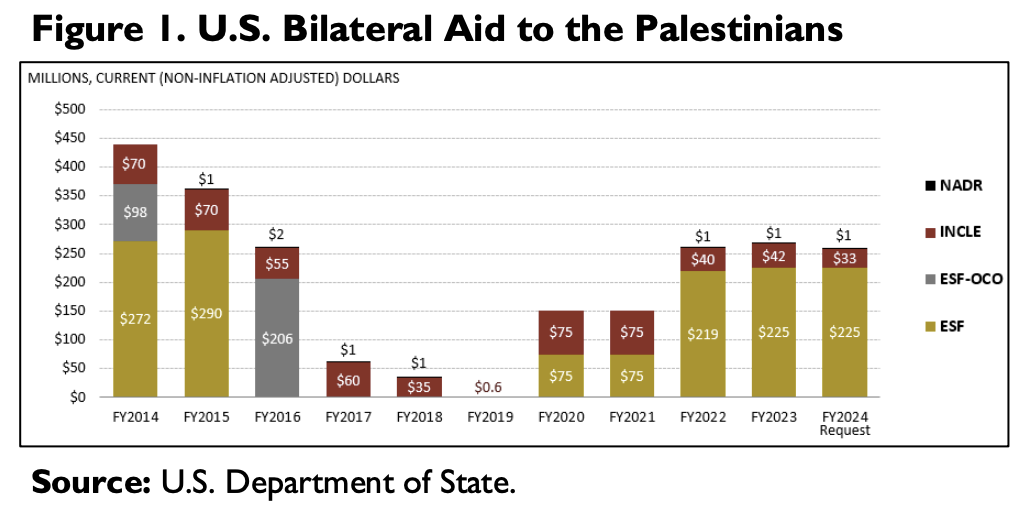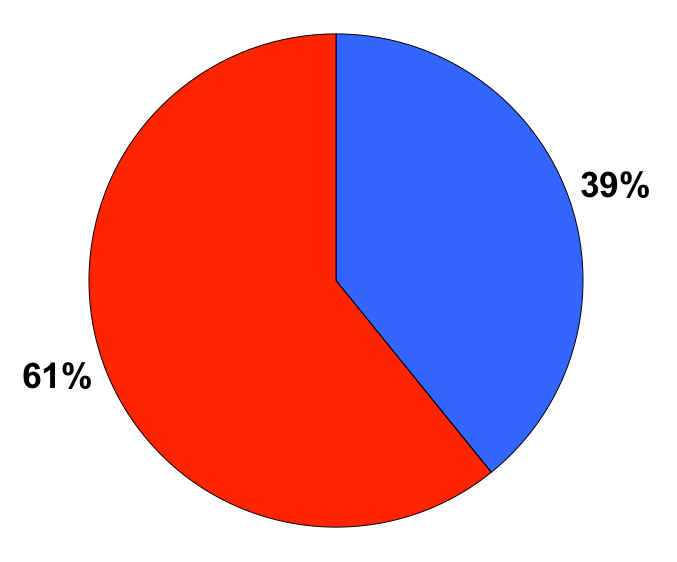| Donate | Contact Us | Materials | Subscribe | Israel-Palestine Timeline | Israel-Palestine News | |
 |
|
U.S. Aid to Israel and to PalestiniansThe U.S. provides Israel more than $63 million* in military aid per day,
|
|||||||||||||||||||||||||||||
|
'The Staggering Cost of Israel to Americans' Booklet |
In addition to this direct aid to Israel:
Like many government policies, this disbursement of U.S. tax money is not because it serves American interests, but instead is the result of special interest lobbying.
Contrary to ordinary U.S. policy, Israel has been and continues to be allowed to use approximately a quarter of U.S. military aid to purchase equipment from Israeli manufacturers. According to CRS, “no other recipient of U.S. military assistance has been granted this benefit.” (In some years this percentage has increased to as high as 38.7%.)

The MOU requires this Off-Shore Procurement (OSP) to phase out over time, ending entirely in FY2028. However, according to the CRS report, Israeli defense contractors are responding to the planned phase-out by merging with U.S. companies or opening U.S. subsidiaries to continue their elegibility for defense contracts financed through FMF.
Thanks in part to this indirect U.S. subsidy, Israel’s arms industry has become one of the strongest in the world, and competes with US companies. Between 2001 and 2008, Israel was the 7th largest arms supplier to the world, selling $9.9 billion worth of equipment. And it continues to grow stronger. In 2021, Israel sold $11.3 billion in military goods to other countries.
The former assistant Secretary of Defense from 2007 to 2009 asked, "How inexplicable is it that we are competing against the Israelis in the Indian defense procurement market at the same time we are subsidizing the Israeli defense industry?"
By all accounts the United States has given more money to Israel than to any other country. According to the Congressional Research Service, as of January 2023, in constant 2021 U.S. dollars (inflation-adjusted), total U.S. aid to Israel obligated from 1946-2023 is an estimated $260 billion.
Cumulative US foreign assistance obligations between 1946 and 2022 to the top ten recipients. Inflation-adjusted to 2022 dollars. (source)
In a Washington Report article published in October 2013, Shirl McArthur writes, “[T]he indirect or consequential costs to the American taxpayer as a result of Washington’s blind support for Israel exceed by many times the amount of direct U.S. aid to Israel. Some of these ‘indirect or consequential’ costs would include the costs to U.S. manufacturers of the Arab boycott, the costs to U.S. companies and consumers of the Arab oil embargo and consequent soaring oil prices as a result of U.S. support for Israel in the 1973 war, and the costs of U.S. unilateral economic sanctions on Iran, Iraq, Libya and Syria.
(For a discussion of these larger costs, see ‘The Costs to American Taxpayers of the Israeli-Palestinian Conflict: $3 Trillion,’ by the late Thomas R. Stauffer, June 2003 Washington Report, p. 20.)”
**Source for US Aid to Palestinians: OFFICE OF INSPECTOR GENERAL, U.S. Agency for International Development
For additional information see: The Congressional Research Service's Report The Palestinians: Overview, Aid, and U.S. Policy Issues, (Updated January 24, 2024), “U.S. Foreign Aid to the Palestinians”, written by Jim Zanotti, Analyst in Middle Eastern Affairs, dated May 18, 2018; U.S. Resumption of Foreign Aid to the Palestinians, April 14, 2021; and The Palestinians: Background and U.S. Relations, October 27, 2022.
The U.S. government has never provided Palestinians with military aid. "The Department of Defense Appropriations Act, 2015 (H.R. 4870), which passed the House in June 2014, contained provisions that would prohibit funds made available by the act from being obligated to the PA (§10033) or from being used to transfer weapons to the PA (§10024)."
Aid to Palestinians is largely designated for humanitarian and development needs that result from the Israeli occupation and to the Palestinian Authority for policing on behalf of Israel. Such funds are only authorized once Congress has received proof that they will be used for "non-lethal assistance." The most recent CRS report on Palestinian aid states that Palestinian groups received $225 million in economic assistance and $42 million for non-lethal security for FY 2023.
Regarding U.S. aid to the Palestinian Authority, many Palestinian experts assert that the support actually helps Israel maintain its illegal occupation of Palestinian land. "Security collaboration" between the PA and Israel means that Palestinian police are being outsourced to monitor and respond to Palestinians resisting the Israeli occupation or protesting against Israel's assaults on Gaza.
In addition, much of the "humanitarian aid" is dispensed on behalf of Israel.
 (Source)
(Source)(For expenditures on behalf of Israel, go here.)
The U.S. Agency for International Development (USAID) has provided the Palestinian people with some indirect economic assistance through funds distributed to U.S.-based NGOs operating in the West Bank and Gaza. According to CRS, "Funds are allocated in this program for projects in sectors such as humanitarian assistance, economic development, democratic reform, improving water access and other infrastructure, health care, education, and vocational training." The program is subject to a vetting process and to yearly audits...
Since its creation in 1949, the United Nations Relief and Works Agency for Palestine Refugees in the Near East (UNRWA) has received financial backing from each presidential administration, whether Democrat or Republican. The UNRWA “provides food, shelter, medical care, and education for many of the original refugees from the 1947-1949 Arab-Israeli war and their families—now comprising approximately 5 million Palestinians in Jordan, Syria, Lebanon, the West Bank, and Gaza." (Learn more about Palestinian refugees.)
UPDATE: On January 26, 2024, the Biden Administration temporarily “paused” all U.S. funding to the United Nations Relief and Works Agency for Palestine Refugees in the Near East (UNRWA), citing allegations (without evidence) that 12 UNRWA employees (out of a staff of 13,000 in Gaza) were involved in the October 7, 2023 attacks.
Though the United States’ yearly allocation to the UNRWA typically amounted to less than one tenth of its military aid to Israel each year, the funds nonetheless made up nearly a third of the agency’s annual budget. In August of 2018, the Trump administration’s State Department issued a press release announcing an indefinite cessation of all UNRWA funding from the United States effective immediately, a decision described by the UN Commissioner-General as the agency’s “greatest financial crisis in its history.” UNRWA funding resumed under the Biden administration in 2021.
Additionally, "about $50 million in US assistance to the Palestinians does not flow directly to the PA but instead to Israel, which uses the money in part to pay off Palestinian debts to Israeli service providers such as electricity companies."
U.S. aid to the PA also makes it easier and cheaper for Israel to spend its own US aid on security for its Jewish-only settlements built on confiscated Palestinian land, which is illegal under international law. Recent research has shown that at least 78% of international aid money to the West Bank and Gaza ends up in Israel's economy.
From October 7, 2023 through September 30, 2024, the U.S. gave Israel a total of at least $17.9 billion. This works out to $49,041,095.89 per day. The Watson Institute document reports the following specifics:
For Fiscal Year 2023, according to the 2023 CRS report, "U.S. Foreign Aid to Israel," the United States gave Israel at least $3.3 billion in direct bilateral military aid – also referred to as Foreign Military Financing or FMF. (Note: Israel earns interest on this money until it is spent.) Congress also authorized $500 million for "joint" U.S.-Israel missile defense programs (designed to protect Israeli territory from potential outside threats), and $98.58 million in funding for other cooperative defense and nondefense programs, bringing total military aid to Israel to at least $3.9 billion per year.
Put another way, American taxpayers gave Israel more than $10.7 million per day in 2023.
For Fiscal Year 2022, the US gave Israel $3.3 billion in direct bilateral military aid. Congress also authorized $1.5 billion for "joint" U.S.-Israel missile defense programs, bringing total military aid to Israel to $4.8 billion for the year.
Previous charts compared military aid to the two populations, and explained the overall situation on this source page. Since we found some people were confused by the chart, we have now changed it to include humanitarian aid to the Palestinians and explained it in this source page.
Last updated: 10/22/2024
| WATCH: 20 Million Per Day on Behalf of Israel - The Facts |
|
|
| Israel-Palestine Timeline |
 |
Israel-Palestine Timeline: The human cost of the conflict records photos and information for each person who has been killed in the ongoing violence. |
| History of the Israel Lobby |

Buy it on Amazon, and visit the book website for reviews, more ordering options, and upcoming author events. |
| IsraelPalestineNews.org |

Information largely missing from U.S. news reports. Read the Blog |
| How many people have died from Gaza rockets into Israel? |
|
|
| Recent poll on US aid to Israel |

According to a recent survey, over 60% of Americans believe the United States gives "much too much" or "too much" foreign aid to Israel. Read more |
| Additional Resources |
Book – Fallen Pillars: US Policy towards Palestine and Israel since 1945 |
| Organizations |
| Stay Informed |
|
Sign up for our mailing list and receive an email whenever we post a new article on our news site, Israel-Palestine News. |
This website is printer-friendly. Please Print this article and share it with your friends and family.